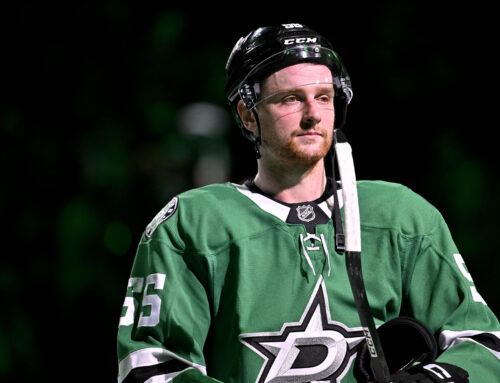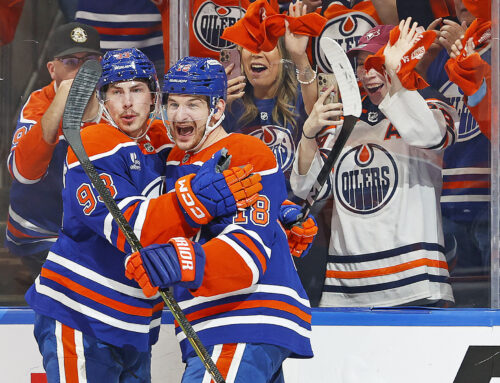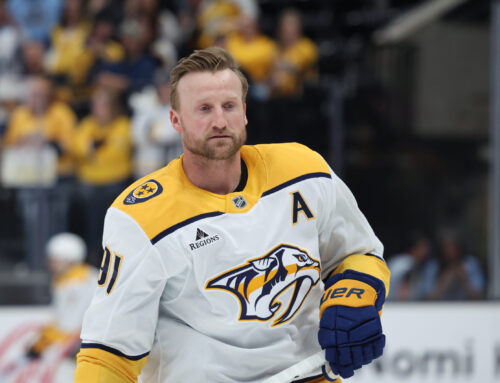
Michael Amato looks at Jimmy Howard’s strong play in 2013.
When Nicklas Lidstrom retired this past off-season it certainly would have given fans and many in the Detroit Red Wings organization a fearful outlook on the future. Perhaps what worried everyone more than the loss of their franchise defenseman, was the fear of the unknown. Lidstrom had been a fixture on the Red Wing blueline for 20 years. Some young fans in Detroit probably couldn’t imagine a scenario without the seven-time Norris Trophy winner being a part of the squad.
The loss of Lidstrom was so devastating because like many other great players, he has a trickle down effect throughout the roster. Just look at what he did for his defense partner Ian White last year. White enjoyed a career revival in 2011-12 and had one of his best statistical seasons ever, with 32 points and a plus-23 rating. In 2013, without Lidstrom, White has really struggled with just two points so far and has even been a healthy scratch on several occasions.
Lidstrom’s departure would have had many concerned from an offensive perspective, but the Swede had an innate talent to defend effortlessly. His ability to shut down opponent’s top lines is something Detroit has relied on greatly over the years. Now that he’s gone, there will be a lot more pressure placed squarely on the shoulders of goaltender Jimmy Howard.
Howard had a breakout last season in the Motor City and was named an All-Star. His six shutouts, .920 save percentage, and 2.12 goals against average gave Detroit something they haven’t had in quite some time, top notch goaltending. Sure, the Red Wings have had adequate play between the pipes over the past 20 years, but they have never had that guy who was among the league’s elite. Whether it was a past his prime Dominik Hasek or a steady, but not flashy Chris Osgood, the Red Wings goaltending has been good, just not great. Howard now brings them to that next level, and with an aging and changing core of players, Detroit needs him now more than ever.
Looking at Howard’s numbers at a quick glance from 2013, you will notice they have slightly fallen from last year’s totals. However, Howard’s play this season may be his most impressive work to date. Detroit has not been playing like the typical defensive juggernaut we are accustomed to, and are doing very un-Red Wing like things. Howard is now being counted on to win them games, as opposed to just giving them a chance to win.
Detroit is usually one of the league’s best when it comes to shots against, but this year that has been a different story. The Red Wings are currently 12th in that category and are giving up nearly two more shots a game than last season, when they ranked third in the NHL. A difference of two shots might not sound like a lot, but over the campaign they can really add up. In fact, last season Howard didn't even rank in the top 20 when it came to shots against, but in 2013 only five other goalies have faced more shots than the Detroit netminder.
|
Rank |
Player |
Team |
SA |
|
1 |
MILLER, RYAN |
BUF |
749 |
|
2 |
NABOKOV, EVGENI |
NYI |
657 |
|
3 |
BRYZGALOV, ILJA |
PHI |
635 |
|
4 |
DUBNYK, DEVAN |
EDM |
630 |
|
5 |
VARLAMOV, SIMEON |
COL |
611 |
|
6 |
HOWARD, JAMES |
DET |
608 |
|
7 |
PAVELEC, ONDREJ |
WPG |
598 |
|
8 |
RINNE, PEKKA |
NSH |
586 |
|
9 |
NIEMI, ANTTI |
S.J |
568 |
|
10 |
LUNDQVIST, HENRIK |
NYR |
559 |
While these kinds of statistics may be frightening to some poolies because it increases the chance he will give up goals, they can actually help Howard owners greatly depending on your league categories. Many pools now have total saves as a statistic and the more shots you face, the more saves you are going to pickup. Howard has made the fifth most stops in the NHL so far in 2013.
Not only is Howard facing more rubber this season, but the degree of difficulty of the shots he is seeing is getting tougher. In 2011-12 the average shot distance that Howard was contending with was 35.21 feet. This year though, that number has crept in slightly to 34.61 feet, making his stops a little more challenging. In addition to that, Howard ranks third in shots faced from 1-15 feet, which are usually the toughest saves to make.
|
Rank |
Name |
Team |
GP |
Shots ↑ |
Goals |
Save% |
|
1 |
MILLER,RYAN |
BUF |
23 |
173 |
22 |
0.873 |
|
2 |
NABOKOV,EVGENI |
NYI |
21 |
165 |
25 |
0.848 |
|
3 |
HOWARD,JAMES |
DET |
22 |
154 |
29 |
0.812 |
|
4 |
VARLAMOV,SIMEON |
COL |
20 |
147 |
28 |
0.810 |
|
5 |
LUNDQVIST,HENRIK |
NYR |
20 |
144 |
21 |
0.854 |
Although the Detroit defense has made it more difficult on Howard in some respects, they have improved other aspects of their game to at least give him a fighting chance. In 2013 the Red Wings have gotten better in the blocked shot department by going from 28th last season, to 23rd in 2013. This also illustrates how many more shots Howard could be facing if not for the added blocks.
The Red Wings have also decreased their giveaways per game with only 7.6 this year, compared to 8.9 in 2011-12. Having more puck possession obviously limits your opponent’s ability to score and generate chances. You know the old saying, “The best defense is a good offense.” Or as Jacques Lemaire might put it, “The best defense is one that sucks the life out of hockey and destroys television ratings.”
Detroit has always been a franchise with an ability to adapt. You don’t make the playoffs for 21 straight years without learning a thing or two about how to adjust to the hand you have been dealt. The Red Wings have always had a strong enough roster where they could get by with just decent goaltending, but although they still have talent, that is no longer the case. Howard has proven himself to be up to the challenge, and if he continues to play at a high level, this Detroit group can still find themselves contenders for a championship. Howard’s numbers may not surpass his production from last year, but his value to the Red Wings organization is at an all-time high.
Feel free to follow me on Twitter at @amato_mike
Previous Wild West posts:





 SEA
SEA NYI
NYI BUF
BUF DAL
DAL
 CBJ
CBJ NYR
NYR ANA
ANA STL
STL L.A
L.A
